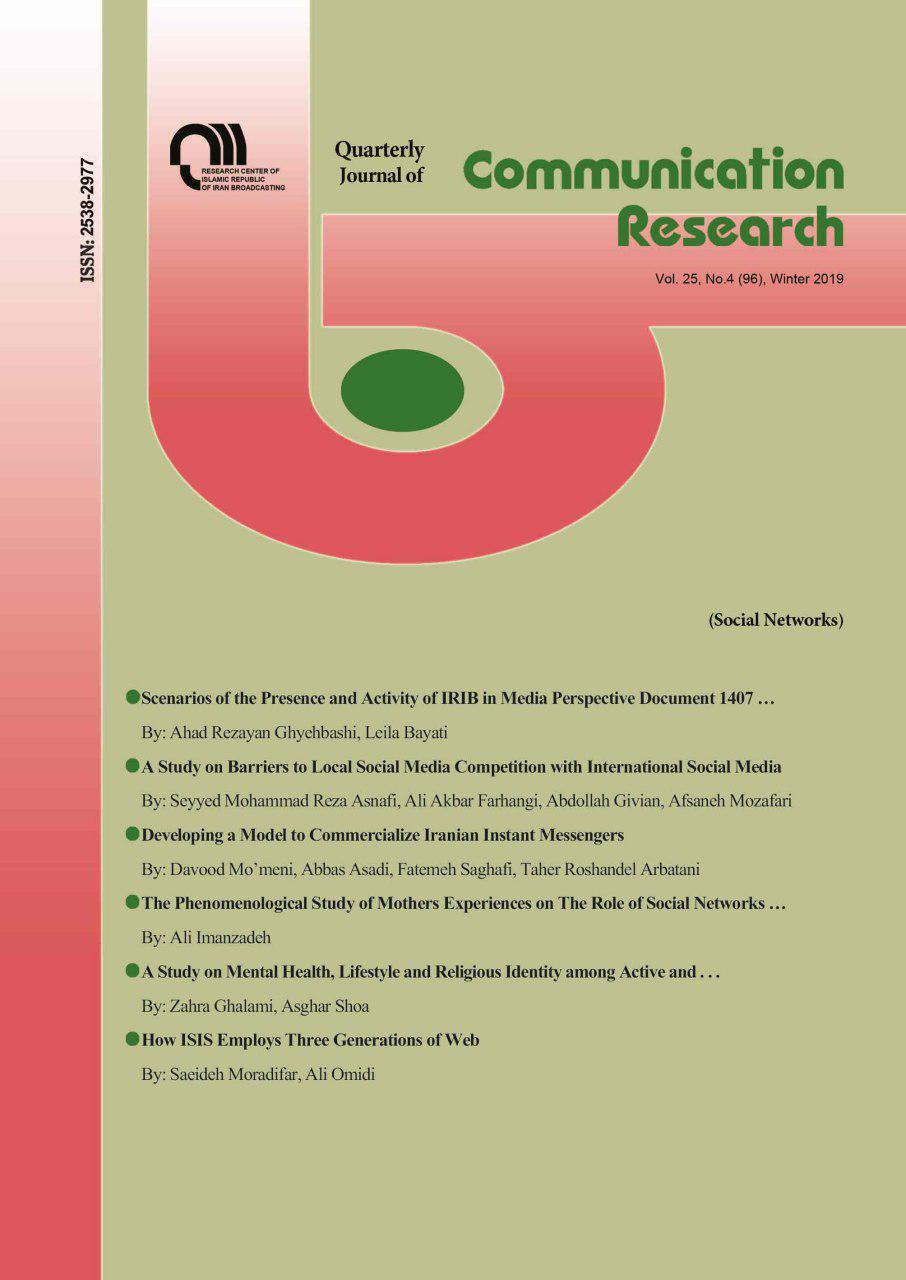Asgari, P.; Safarzadeh, S. & Mazaheri, M. M. (2013). The Relationship Between Religious Belief And Hope To Life With Spiritual Well Being. Journal Of Intercultural Studies, 7 (18), 135-157.
Bashir, H. & Afrasiabi, M. S. (2012). Internet Social Networks and Youth Life Style: A Case Study of The Largest Iranians’ Virtual Community. Journal of Iran Cultural Research, 5 (1), 31-62.
Bayat, M. K. & Manouchehri, R. A. (2015). A SWOT Analysis of the Role Of Social Media In The Lifestyle Of The Members Of Public Libraries (Case: Shiraz City). Journal of New Media Studies, 1 (3), 233-275.
Faramarziyani, S.; Hashemi, Sh. & Farhangi, A. A. (2016). The Role Of Using Mobile-Based Social Networks On Social Values A Case Study of Youths And Adults Residing In Five Iranian Provinces. Journal of Communication Research, 23 (87), 113-135.
Fathi, H. & Jafari A. (2017). The Relationship between Media Consumption And Life Style Changes Among Students Of Islamic Azad University. Journal of New Media Studies, 3 (9), 221-255.
Forghani, M. M. & Mohajeri, M. (2018). The Relationship between The Use of Figurative Communication Networks And The Changes In The Life Style of Youth. Journal of New Media Studies, 4 (13), 259-292.
Ghasemi, V.; Adlipour, S. & Kianpour, M. (2012). Interaction in Virtual Social Networks and Its Impact On The Religious Identity of The Youth In Isfahan City. Journal of Religion and Communication, 19 (42), 5-36.
Hashemi, S. H. & Zare, S. (2016). The Relationship between Students’ Religiosity And Their Mass Media Use (Case: Students ofthe Universities of Qom). Journal of Intercultural Studies of Media and Culture, 6 (12), 197-212.
Javadi Yeganeh, M. R.; Azizi, J. & Ansari, M. R. (2013). International Mass Media and Religious Identity Among The Youth Of Shiraz. Journal of Sociology of Social Institutions, 11 (1), 83-102.
Khajir, U. (2017). Pathology of Using Social Networks And Mobile Software In The Iranian Family (Emphasizing The Strengths, Weaknesses, opportunities And Threats). Women Strategic’s Studies, 20 (77), 109-137.
Khoushavi, F. (2011). The Relationship Between Religious Identity And Happiness In Students of Islamic Azad University Of Najafabad. (M.A. Thesis). Shahid Beheshti University, Tehran.
Mirfardi, A.; Mokhtar. M. & Valinezhad, A. (2017). The Study of Religious Identity And Its Relationship To Degree And Kind of Web-Based Social Networks Usage (Case: Yasouj University Students). Journal of Applied Sociology, 28 (2), 1-16.
Mohammanzadeh, J. & Khosravi, A. (2013). The Relationship between Purpose in Life, Coping Styles And Mental Health Among University Students. Journal of Journal of Health System Research, 8 (6), 951-958.
Mosivand, M.; Safayi, S; Shakib, A. & Viseh, S. M. (2017). The Effect of Web Based Social Networks on The Religious Identity Of Iranian Second And Third Decade, Students (Case: Hamedan Universities). Journal of Culture In The Islamic University, 7 (25), 503-524.
Pournaghdi, B. (2018). Opportunities and Security Threats In Virtual Networks For Students. Journal of Strategic Research On Social Problems In Iran, 7 (2).
Ra'oofi, M. (2010). Religious Identity Components. Journal of Religion And Communication, 17 (37-38), 91-112.
Rogh, C.; Mohammadi Aria, A. R. & Tajeri, T. (2018). The Relationship between Lifestyle And Nutritional Patterns With Self-Esteem And Mental Health In Secondary School Girl Students. Journal of SOCIOLOGY OF EDUCATION, 6 (6), 62-68.
Sahaghi, H. (2018). Relationship Between Mental Health And Happiness With Academic Achievement In Students Of Jondishapour Of Ahvaz. Journal of Development Strategies in Medical Education, 5 (1), 15-24.
Salehi, A. & Baradaran, M. (2016). Phenomenological Pathology of Internet Role on the Youths’ Religious Beliefe. Journal of Akhlagh, 2 (43), 213-241.
Shamani, E.; Vahedi, M. & Norouzi, D. (2016). The Relationship between Use of Virtual Social Network with Cultural Identity (Tehran). Journal of Culture Counseling, (28), 163-182.
Talebpour, A.; Mansouri, F. & Rostami, T. (2017). The Impact of Unconventional And Indiscriminate Use Of Social Networks On Youth Tendency To Social Disorders (Case: Kermanshah City). Irnian Journal Of Social Problems, 8 (2), 103-126.
Vadodi, E. & Delavar, A. (2015). Studying Virtual Networks Effects on Changing the Young’s Personality Characteristics. Journal of Educational Psychology, 11 (35), 44-65.

